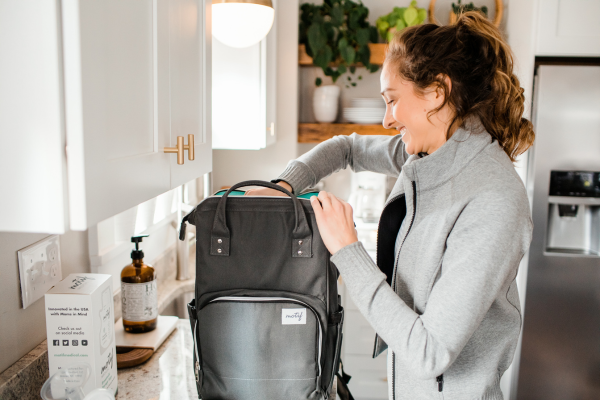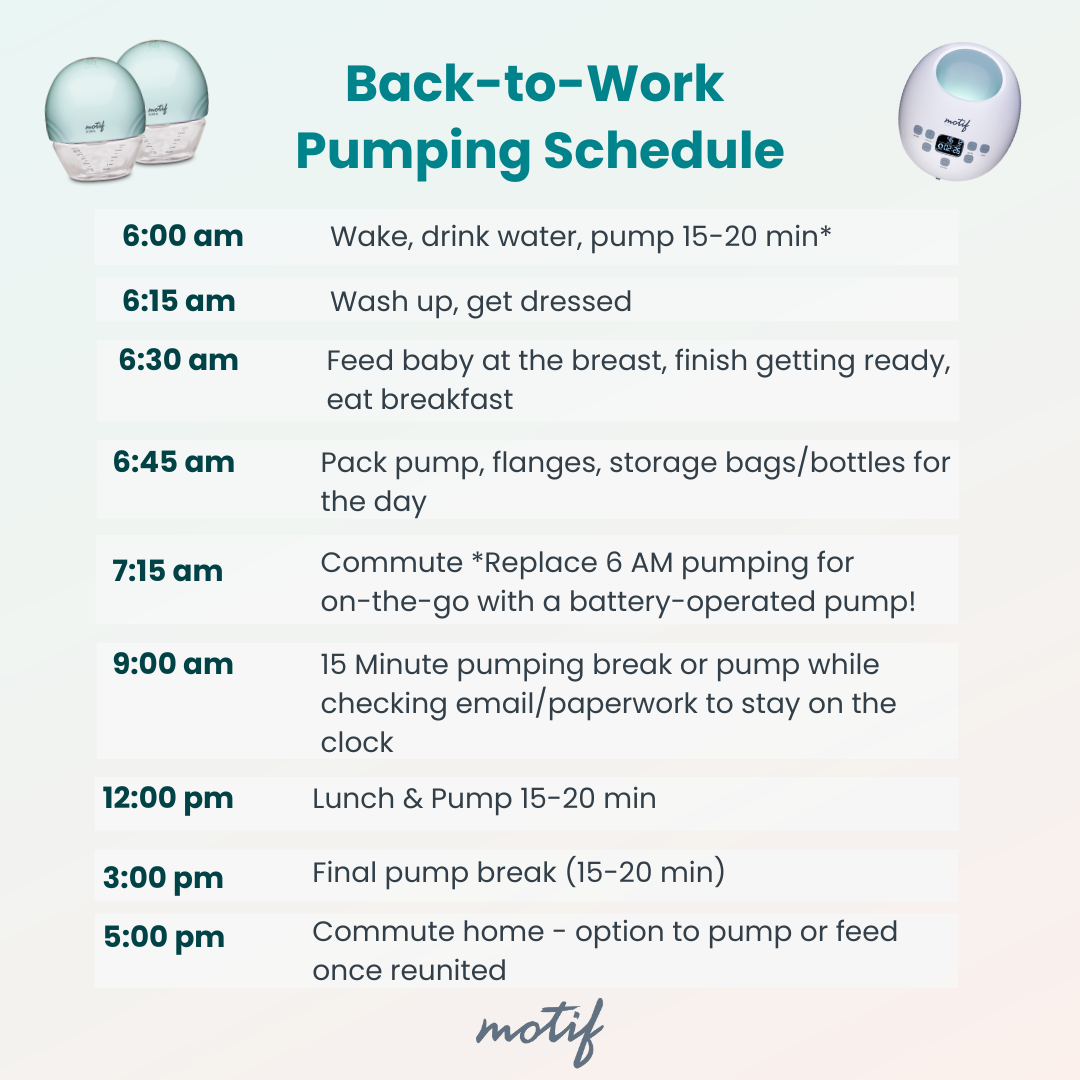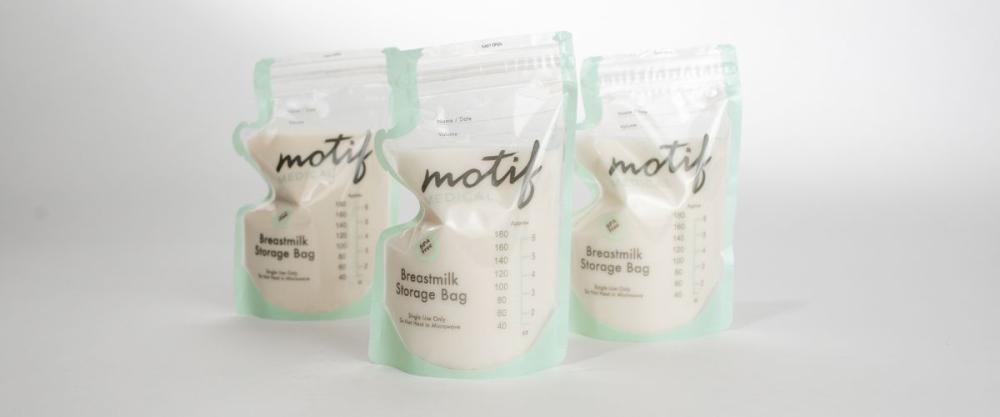Where do you start when deciding to develop a pumping schedule for work? You have goals to protect your milk supply and have enough milk to leave for the caregiver or daycare, maybe continue breastfeeding when you’re home, and be comfortable throughout your work day.
On Maternity Leave
If you have other working moms in your community, friend group or workplace, ask them about what it’s like breast pumping at work. Ask if your boss seemed flexible about it, what the lactation room is like, and if they have any tips. How long were their pumping sessions? Did they need a freezer stash? They’ve done it before and most likely have helpful advice about pumping at work to share.
Then schedule a meeting with your boss or HR professional to discuss your plan to breast pump at work after your maternity leave. Be open with them about how you will need to pump every few hours. Having a pumping at work schedule prepared can help.
Most moms breast pump before work, a few hours later around 10 AM, during lunch break around 12:00-12:30 PM, again in the afternoon around 3 PM and right after work. Be flexible and willing to work with your employer to determine the best pumping schedule.
If you're building a milk stash for work or extended separation during the day, begin with 1-2 pump sessions a day 2 weeks before you need it. Mornings may work best, as there tends to be more volume to work with.
Things to keep in mind:
- Pumping sessions should be kept similarly to average feeding times, i.e. 15-20 minutes and at least every 2-3 hours
- A freezer-full of milk is NOT needed! The average amount needed for when away from baby is 1 oz for every hour away, i.e. 8 hour work day + 60 min commute total = 9 hours, 9-10 oz/day will do perfectly! PLUS you will continue to pump while away, not just for ahead of time.
- If you get nervous, remember under the Fair Labor Standards Act (FLSA) employers with 50 or more employers must provide reasonable break time for mothers to express breast milk for up to a year after their child’s birth. They must also provide a private space other than a bathroom for the purpose of breast pumping.
Daycare and Caregivers
Start communications now with whoever will be caring for your little one. Discuss bottle feeding a breastfed baby, expectations for amount of milk to be given per feeding, and when the time is appropriate for solids. Formula is typically given in larger amounts per feeding, and caregivers may unknowingly feed too much, which will put pressure on nursing mothers to keep up with an unnecessary stash. Ask about packing preferences: do they need ice packs or do they have access to a refrigerator?


Which Breast Pump Will Serve You Best?
Not all breast pumps are created equally, so it’s important to research your options to determine the best option for pumping at work. A double electric breast pump will help quickly express milk from both breasts at once, while hands-free pumping, with a wearable pump will allow you to keep working, move about and multitask.
You will also need a lightweight option for traveling and forth from work unless you leave a spare pump in your lactation room. Make sure the pump is battery powered in case the room doesn’t have an outlet or you find yourself needing to express milk away from the pumping room.
Everyone wants an abundance of milk to not worry about, but not everyone has the same lifestyle or situation. Are you breastfeeding at home once you’re back with your baby, or are you exclusively pumping? You will need an electric pump, most likely a desktop pump, to keep up with larger volume needs if exclusively pumping or pumping for multiples, while a wearable pump is a great compliment to have for part-time pumping needs.
Start Pumping Before You Return Back to Work
Get comfortable and acquainted with your pump before you are reliant on it. How long is your pumping time? Do you like your pumping bra? You will be ready for your first day back with good preparation, and feel confident in your goals.
When is Pumping Needed?
Separation from Baby for 4+ Hours or More
Milk removal should occur every 2-3 hours, sometimes even more often than that. If feeding is not an option for a length of time, it’s important to still have means to remove it and not let it sit stagnant in the breasts.
This prevents build up of FIL, a protein that communicates usage of milk or lack thereof, as well as preventing potential clogs from fatty milk. Milk flow also keeps the ducts and nipples flushed of bacteria and yeast that can cause mastitis and thrush.
Sample Pumping Schedule for Working Moms


While this is a sample of one circumstance, making pumping frequency is not as daunting as it sounds. Working with the workflow can make keeping up with pumping much easier, and set an example for balance for employers and coworkers, plus it can be used as a much-needed mental break.
If you have more questions, the best option is always to see a lactation consultant!
Tips for While You're at Work
- Wear button-down shirts or loose fitting clothes to give yourself easy access to your ladies. Also, wear a hands free nursing bra to give you the ability to multitask.
- Stay hydrated. Drink water all day to help stimulate your milk flow.
- Let emotions come. Missing your baby and lactating aren’t easy. If you feel a wave of sadness coming excuse yourself to your car or a private space until you’re ready to return to work.
- Try to keep your schedule as regular as possible to avoid issues such as engorgement.
- If someone stops you on the way to the breast pumping room, calmly explain that you have something to take care of and you’ll meet with them in about 20 minutes.
- If you forget part of your breast pump or something breaks, don’t panic. You can hand express breastmilk.
- Distract yourself. Take your laptop.
- Clean your pumping gear in between uses OR keeping the parts in a bag in the refrigerator to wash when you get home. If your pumping room has a sink, and you need to wash them, wash your pump parts with warm soap and water. Also, some breast pump parts can be sanitized in the microwave, and if you need to clean in a snap use breast pump wipes. Make sure to sanitize once you are home, which can be by boiling 2-3 minutes on the stove, or washing in dishwasher, or using sanitizing microwavable bags. Please note that physically washing/scrubbing is still required prior to sanitizing to remove residue.
As a mom, you’re more-than-likely sleep-deprived which can make it hard to pack everything you need while rushing in the morning before work. Take a moment to create a checklist of everything you’ll need to pack the night before. Even jotting down your breastfeeding schedule to help keep track of when you need pumping breaks may be helpful!
Packing the night before will also help you to prevent accidents from happening. Things don’t always go according to plan, but by being prepared a simple mistake won’t have to ruin your whole day or throw off your pumping schedule. (I can recall forgetting storage bags or my pumping flanges many times!)
Information provided in blogs should not be used as a substitute for medical care or consultation.







